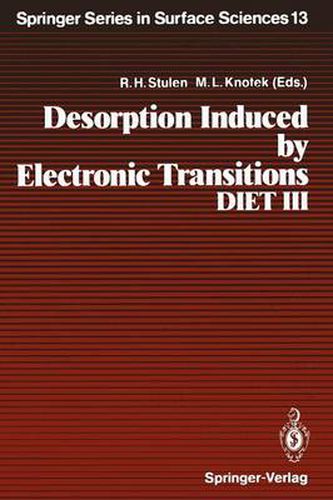Readings Newsletter
Become a Readings Member to make your shopping experience even easier.
Sign in or sign up for free!
You’re not far away from qualifying for FREE standard shipping within Australia
You’ve qualified for FREE standard shipping within Australia
The cart is loading…






This title is printed to order. This book may have been self-published. If so, we cannot guarantee the quality of the content. In the main most books will have gone through the editing process however some may not. We therefore suggest that you be aware of this before ordering this book. If in doubt check either the author or publisher’s details as we are unable to accept any returns unless they are faulty. Please contact us if you have any questions.
These proceedings are the result of the third international workshop on Desorption Induced by Electronic Transitions, DIET III, which took place on Shelter Island, NY, May. 20-22, 1987. The work contained in this volume is an excellent summary of the current status of the field and should be a valuable reference text for both seasoned researchers and newcomers in the field of DIET. Based on the success of the meeting it seems clear that interest and enthusiasm in the field is strong. It is also apparent, from the many lively discussions during the meeting, that many unanswered questions (and controversies) remain to be solved. It was particularly pleasing to see many new participants from new and rapidly advancing fields, ranging from gas phase dynamics to semiconductor processing. The resulting cross-fertilization from these separate but related fields is playing an important role in helping us understand desorption processes at solid surfaces. In general, the topics covered during the course of the workshop over lapped those of both DIET I and DIET II. However, clear advances have been made and in general there is a much more sophisticated understand ing of the physics and chemistry of stimulated desorption. Of particular note in this regard is the gas phase research highlighted in this workshop by the work of Nenner et al. , where new results indicate that in the gas phase, photodissociation can precede or compete strongly with autoion ization and other electronic relaxation pathways.
$9.00 standard shipping within Australia
FREE standard shipping within Australia for orders over $100.00
Express & International shipping calculated at checkout
This title is printed to order. This book may have been self-published. If so, we cannot guarantee the quality of the content. In the main most books will have gone through the editing process however some may not. We therefore suggest that you be aware of this before ordering this book. If in doubt check either the author or publisher’s details as we are unable to accept any returns unless they are faulty. Please contact us if you have any questions.
These proceedings are the result of the third international workshop on Desorption Induced by Electronic Transitions, DIET III, which took place on Shelter Island, NY, May. 20-22, 1987. The work contained in this volume is an excellent summary of the current status of the field and should be a valuable reference text for both seasoned researchers and newcomers in the field of DIET. Based on the success of the meeting it seems clear that interest and enthusiasm in the field is strong. It is also apparent, from the many lively discussions during the meeting, that many unanswered questions (and controversies) remain to be solved. It was particularly pleasing to see many new participants from new and rapidly advancing fields, ranging from gas phase dynamics to semiconductor processing. The resulting cross-fertilization from these separate but related fields is playing an important role in helping us understand desorption processes at solid surfaces. In general, the topics covered during the course of the workshop over lapped those of both DIET I and DIET II. However, clear advances have been made and in general there is a much more sophisticated understand ing of the physics and chemistry of stimulated desorption. Of particular note in this regard is the gas phase research highlighted in this workshop by the work of Nenner et al. , where new results indicate that in the gas phase, photodissociation can precede or compete strongly with autoion ization and other electronic relaxation pathways.